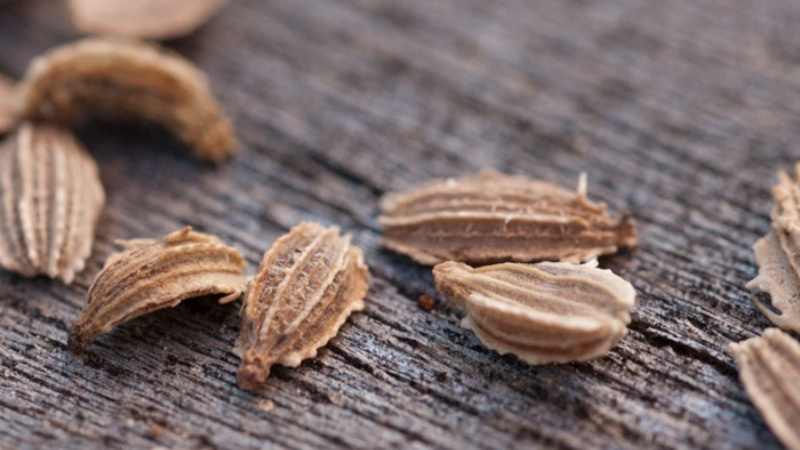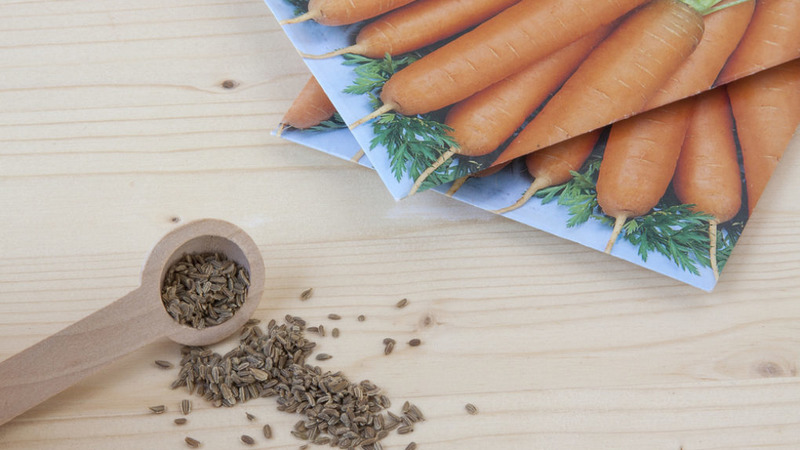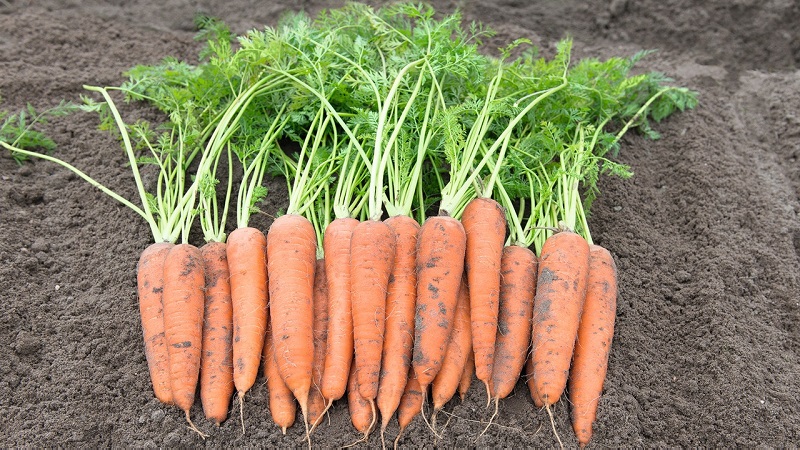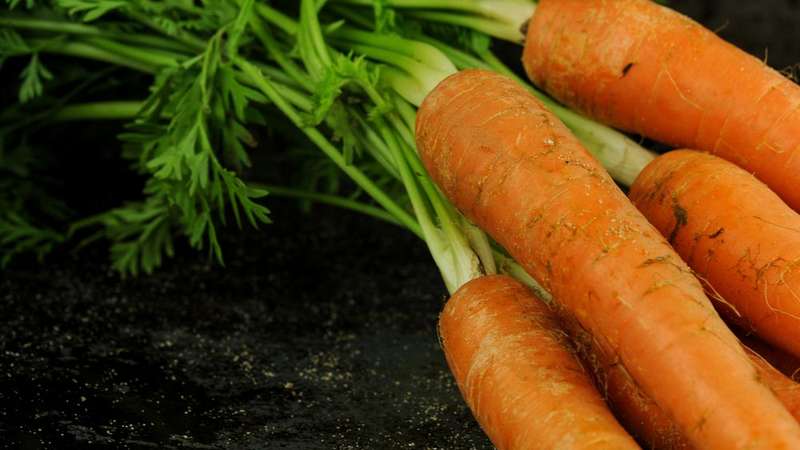What are carrot seeds, how to choose them correctly, plant and grow them yourself
Carrots are present in the diet of many people almost every day - as part of first and second courses, salads, casseroles, pies. Children love orange root juice. But few people know what benefits are stored in carrot seeds. They help in the treatment of various diseases, relieve symptoms of difficult pregnancy, relieve cramps and increase immunity. In this article, we will tell you about carrot seeds: what medicinal properties they have, how to grow and preserve them correctly.
The content of the article
- Where do carrot seeds come from?
- Types of carrot seeds
- Chemical composition of seeds
- How are they used in traditional medicine
- How to choose the right carrot seed variety
- How to properly plant carrot seeds
- When and how to harvest carrot seeds
- Storage rules and shelf life
- Carrot seeds on paper tape
- Conclusion
Where do carrot seeds come from?
Carrots are a biennial plant, so most gardeners do not see how they bloom and produce grains.
In the first year, only greens and root crops are formed. In the second year, carrots throw out arrows with small flowers. Seeds are formed at the end of the growing season.
How do they look

The grains are oval-elongated, on the surface there are ribs with thorns. Outwardly, they are similar to parsley seeds, but the latter, when pressed, turn greenish, and carrot seeds turn a little yellow.
Types of carrot seeds
For planting, use purchased and self-grown seed.
Conventional
The simplest seeds are cheaper, but also more difficult to plant. They are so small that 1 g contains from 500 to 1000 seeds. The plantings are dense, and they are thinned out. In this case, the weak roots of neighboring seedlings are inevitably damaged.
Granular
Pelleted seeds are more convenient because they can be sown immediately at the desired distance. They are more expensive, but the resulting savings are greater. The dragee shell consists of nutrients that promote better seed germination and full development of sprouts.
Chemical composition of seeds

Purchased and home-grown carrot seeds have approximately the same set of nutrients. Both contain a large amount of essential oils, due to which the surface of the grains is slightly oily.
Chemical composition:
- glycerides (up to 20% of seed mass): petroselinic, petroselinic, oleic, palmitic, linoleic acids;
- beta-carotene (provitamin A), under the influence of which vitamin A is formed in the human body;
- tocopherols;
- vitamins B, D, E, ascorbic acid;
- minerals: potassium, magnesium, phosphorus, selenium, sodium, zinc, copper, iodine;
- flavonoids.
The vitamins contained in carrot seeds support the health of the skin, eyes, and strengthen the skeletal system. Flavonoids normalize the nervous system. Minerals support the tone of the heart and blood vessels, regulate the body's water-salt balance.
Properties
Carrot seeds have:
- analgesic, sedative, regenerating effects;
- anti-inflammatory and tonic properties;
- diuretic action.
For difficult pregnancies, a decoction of carrot seeds reduces nausea in the first trimester.
How are they used in traditional medicine
For medicinal purposes, the seeds of sowing and wild carrots are used. Umbrellas with ripe fruits are harvested from cultivated plants in July - August, dried and threshed.
In order to prevent the loss of seeds, the inflorescences are wrapped with cloth or gauze and peeled in this form. Store in linen bags or glass jars, tightly closed.
In folk medicine, carrot seeds are used:
- with diseases of the liver and spleen;
- constipation and flatulence;
- high blood pressure;
- violations of the menstrual cycle;
- stones in the gallbladder and kidneys;
- parasites.
In addition, products with carrot grains remove salts from the body, relieve spasms and inflammation.
Reference. In most folk recipes, tinctures and decoctions are prepared from carrot seeds. Sometimes grains are consumed dry.
Contraindications to use - allergic reaction to the product, peptic ulcer, diabetes mellitus, asthma, acute inflammatory diseases of the kidneys and intestines, heart failure.
Carrot seed oil has a healing effect. It is difficult to prepare it at home, but it can be purchased at the pharmacy.
Carrot seed oil:
- heals wounds;
- enhances immunity;
- normalizes the activity of the nervous system;
- has an anti-inflammatory effect.
Wild carrot seeds for treatment
Their use is wider than that of a seed crop. The harvested and dried seeds of wild carrots are ground in a mortar or ground in a coffee grinder.
In folk medicine, wild carrot seeds are used to:
- relief of pain;
- increased sex drive;
- treatment of tuberculosis;
- increased lactation;
- removing stones from the kidneys;
- treatment of osteochondrosis.
Children are given seeds of wild carrots in the form of decoctions to get rid of worms, especially pinworms, relieve intestinal colic, with a deficiency of vitamin A.
How to choose the right carrot seed variety
The choice is determined by the purpose: to obtain root crops or seeds, for summer use or winter storage, with a high content of carotene or minerals. Hybrids marked with the F1 code are not suitable for growing for seeds: they will not give the desired seed.

Selection of early, medium, late varieties
Only late varieties are suitable for winter storage of root crops. Early and mid-season are best consumed as they ripen.
Popular varieties of early carrots (ripening up to 90-100 days from the moment of germination):
- Alenka. High-yielding, disease-resistant variety. A cylindrical root crop, weighing 100-120 g, with a high sugar content, juicy, crispy. The first root crops are obtained in 50 days.
- The Bureau. Ultra-early ripening high-yielding variety. The root vegetable is elongated, almost without a core, smooth, juicy and tasty.
- Touchon. Root crops are cylindrical, weighing up to 140 g, with juicy orange pulp. The variety is resistant to disease and cracking. It is used fresh and for canning.
Early carrots are good because they are ready for use within 1.5 months after sprouting. With late plantings, root crops have a good keeping quality - up to 3-4 months.
The best mid-season carrot varieties:
- Nantes-4... Carrot fly resistant. Root crops have good keeping quality, the carotene content in them is the highest - 18%.
- Delicacy. Root crops are conical, elongated, bright red, with a high sugar content.
- Samson. Large universal root vegetables are used fresh and for the preparation of juices, purees, canning, storage.
Mid-season varieties reach technical ripeness 4 months after germination. They keep well and taste great.
The best mature varieties with a high content of vitamins and minerals:
- Autumn queen. High-yielding carrots with excellent taste. Stores well - practically until the next harvest.
- Autumn giant. Bright orange roots with juicy pulp and high carotene content. Root crops weighing 180-250 g are well stored, resistant to diseases.
- Red giant. Favorite late variety of most gardeners.Root crops are cylindrical, large, with small eyes. High content of carotene and minerals. Cold-resistant variety with good keeping quality.
Late varieties are intended for long-term storage. They are distinguished by good taste, which are not lost for several months. Ripening period - 130-140 days.
The best varieties for open ground and greenhouses

All carrot seeds sold in our country are for open ground. Some of them are suitable for growing in greenhouses.
They proved to be good in protected ground:
- Minicore. Ultra-early maturing and high-yielding variety.
- Nantes. Designed for long-term storage.
- Vitamin. Medium ripening, high in carotene, B vitamins, minerals. Resistant to cracking.
- Losinoostrovskaya-13. A hybrid that gives large cylindrical root crops intended for winter storage.
For cultivation in greenhouses, carrot varieties are suitable that are resistant to diseases and shooting, thermophilic and not demanding on the soil.
Selection of varieties for different regions
To obtain a bountiful harvest, zoned varieties of carrots are chosen. Some are suitable for any region, for example, Chantane or Nantes. But to obtain the maximum yield of high-quality root crops that retain their beneficial properties throughout the winter, they adhere to the conditions to which the culture is demanding.
For the middle lane The best varieties of carrots in Russia are Boltex, Vitaminnaya, Queen of Autumn, Losinoostrovskaya.
For Siberia - Dunyasha, Zabava, Losinoostrovskaya, Nantes.
For steppe regions (Bashkiria, Tatarstan, Yuzhny Ural) - Baltimore, Blues, Vita Longa, Enchantress.
For the south of Russia - Children's, Children's vitamin, Vigo, Samantha, Turbo.
For northern regions - Vigilance, Medoc, Centaur, Charlotte.
A properly selected zoned variety can withstand prolonged droughts or recurrent frosts, grows on acidic or alkaline soils, and is resistant to diseases and pests characteristic of a particular region.
How to properly plant carrot seeds

Planting material is prepared for sowing in advance. Seeds are etched in a weak solution of potassium permanganate for at least a day. Soak in warm water for 2-3 days to get rid of essential oils that slow down germination. After soaking, the seeds are dried or germinated in a dense damp cloth.
Attention! You cannot germinate carrot seeds in gauze. Its thin roots will become entangled in the fibers and break off when trying to extract the seed.
Preparing for landing
The soil for the carrot beds has been prepared since the fall. The garden bed is dug up, plant residues are removed, organic and mineral fertilizers are applied. In the spring, the soil is loosened again, the grooves are cut to a depth of 3-4 cm at a distance of 20-25 cm from each other and watered.
Sowing instructions
To obtain friendly and early shoots and facilitate thinning, carrot seeds are sown in a certain way:
- Dragee-coated they are immediately laid in accordance with the scheme: 15x20 cm for early varieties and 20x25 cm for later ones. This is easy to do, since the pellets are 2-3 mm in diameter. Before planting, the grooves are moistened - this is the main condition for successful germination.
- With sand... For 1 part of the seeds, take 3 parts of sand and mix. Sow in the usual way.
- With paste... In 0.5 tbsp. cold water dissolve 2 tbsp. l. potato starch or 4 tbsp. l. flour. Pour in a thin stream into boiling water (2 tbsp.), Stir and cool. Pour into a plastic bottle, in the lid of which a hole is made, add carrot seeds there and shake. Sow by squeezing the mass into prepared furrows.
- Tape method. Cut the toilet paper into strips according to the size of the beds and 1.5 cm wide. At a distance of 5 cm from each other, carrot seeds are glued using office glue and a toothpick. Spread the prepared tapes into the grooves and sprinkle with soil.
After sowing, the land in the beds is tamped tightly.If voids remain, the light carrot seeds will not gain traction and germinate. There is no need to water after planting.
When and how to harvest carrot seeds

Collect seeds cultivated carrots in July - September, depending on the early maturity of the variety. The inflorescences are cut off before the onset of full ripeness, otherwise the seeds will crumble. Then they are tied in bunches and hung to dry, tied with gauze. Dried seeds are threshed.
Storage rules and shelf life
Store dried carrot seeds in glass jars or linen bags.
Seeds collected with their own hands remain viable for five years. They are suitable for medicinal purposes for three years.
Carrot seeds on paper tape
Manufacturers have adopted the method of planting on toilet paper invented by gardeners. Now the planting material can be purchased ready-made on the tape. A roll 8-10 m long contains seeds in the pockets at the correct distance.
Such a roll is unwound along the grooves spilled with water, sprinkled with soil and tamped.
Conclusion
Carrots are a healthy vegetable for humans. Its seeds are used to treat many diseases and as a preventive measure against excess salts in the body, to maintain immunity, and replenish vitamin deficiencies. Growing carrots for seeds is easy. To get an excellent harvest of root crops, and then - seed material, varieties are correctly selected in accordance with the purpose and region.